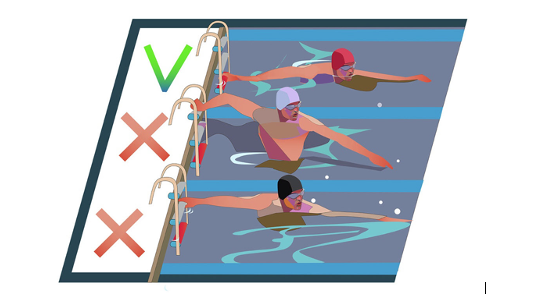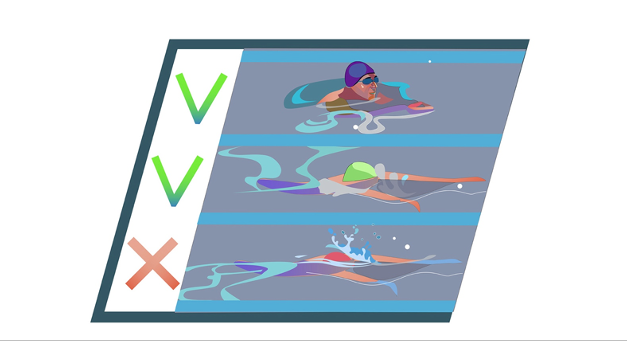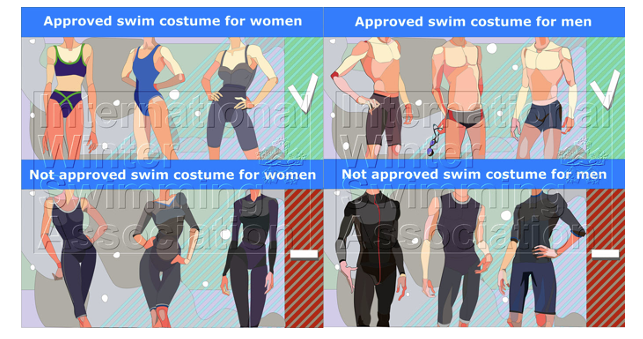The Basic Rules
- Rules For All Races (updated 31 October 2021)
1.1 Swimmers compete within age categories. The age categories for events of the season are determined by the swimmers age on October 31 of seasons second year (i.e. season 2021/2022 is determined by year 2022) IMPORTANT: who was born in November / December should be determined by the full number of years! (See appendix 1 for details).
1.2 At the starting line, competitors will receive the following commands (with the following intervals):
|
1. Take off your clothes |
|
2. Get in the water (5 seconds) |
|
3. On your marks (3 seconds) |
1.3. As competitors enter the water they must get into the start position. The start position is required by the command ‘On your marks’. Competitors must hold the Start Bar (a clearly marked designated step of the ladder) with one hand and put their front shoulder under the water. See appendix 2 for illustration of the permissible start position. Not completing the command ‘On your marks’ may result in 5 seconds penalty added to the race time.
1.4. In 3 seconds after the command ‘On your marks’ the claxon will sound, indicating the start of the race.
1.5. Swimming under the water after START for longer than 5 meters from the start wall (when the swimmer is completely submereged and no part of the swimmer is breaking the surface of the water) is strictly forbidden and will result in 5 seconds penalty added to the race time.
1.6. False starts will not be called back. Blatant false starts will result in disqualification. Minor false starts will result in 5 seconds penalty added to the race time. The decision of the race referee(s) will be final.
1.7. Tumble turns are strictly forbidden. Before making a turn, Competitors must touch the end of the pool wall with, at least, one hand.
1.8. Swimming under the water after completing the TURN for longer than 5 meters from the turn wall (when the swimmer is totally submerged and no part of the swimmer is breaking the surface of the water) is strictly forbidden and will result in 5 seconds penalty added to the race time.
1.9. Swimwear must be appropriate and non-transparent. Swimming without a bathing costume or women swimming topless are not permitted. Except when related to the water performance teams, swimsuits may not go beyond the knee or past the shoulder (legs knee should be open i.e. they may not have legs or sleeves) and shall have no thermal protection or buoyancy. (See Appendix 4)
1.10. To finish the race, a competitor must touch the end of the lane with, at least, one hand.
1.11. The heat results will be final (no extra final heats).
1.12. Competitors must leave the water immediately after the race. They should retrieve their clothes from the provided baskets and should immediately leave the pool area.
- Rules For 25, 50, 100 and 200 meters Breaststroke Races
2.1. The only permissible stroke for 25 and 50 m Breaststroke races is "Head-Up" breaststroke. The crown (the top) of the head must not be submerged during the race, except before the first stroke within the 5 m zone of the start or turns (when water overflow through the head is permitted) – for all age groups, men-women, with time control. If the crown (the top) of the head submerges during the race, when it is not allowed, the swimmer will receive 5 second penalty that will be added to their race time. See appendix 3 for illustration.
2.2. For 100 and 200 m Breaststroke races the water overflow through the head is permitted during the whole course of swimming.
2.3. See Chapter 1 for the race regulations.
Rules For 25, 50 and 100 meters Freestyle Races
3.1. Swimming style is freestyle meaning “any style” for individual swims.
3.2. See Chapter 1 for the race regulations.
- Rules For Ice-Butterfly 25 m.
4.1. Swimming style is a regular butterfly for individual swims.
4.2. From the beginning of the first arm stroke after the start and after each turn, the body shall be kept on the breast.
4.3. Both hands must simultaneously slip forward over the water.
4.4. All the movements of the two legs up and down should be done at the same time during the entire race.
4.5. See Chapter 1 for the race regulations.
- Rules For Relays
5.1. The swimming distance is 4 x 25 meters.
5.2. Teams’ gender must be mixed. There must be, at least, one woman or one man in each team.
5.3. Team must consist of a team Captain and 3 swimmers. Only the team Captain should register the team. The names of the other 3 members should be provided on registration.
5.4. Team members must agree on their start order prior to registration.
5.5. Team member may participate in one breaststroke relay and one freestyle relay.
5.6. When called to the pool area, team members will be instructed take their position at the team’s lane according their start order. The first and third swimmers take the start end of the lane, while the second and fourth swimmers take the turning end of the lane.
5.7. The swimmers must follow the general regulations described in Chapter 1.
5.8. The first swimmer starts as described in Chapter 1.
5.9. There is no claxon signal for the following swimmers. The previous swimmer completing his or her turn by touching the wall signals the start for the subsequent swimmer. The second, third or fourth swimmer must be in the water in the start position while (and before) the incoming teammate is touching the wall.
5.10. The team finishes when the fourth swimmer touches the wall at the end of the lane.
- Rules for Breaststroke Relay
6.1. The only permissible stroke is "Head-Up" breaststroke. The crown (the top) of the head must not be submerged during the race, except before the first stroke within the 5 m zone of the start or turns (when water overflows through the head is permitted). If the crown (the top) of the head submerges during the race, when it is not allowed, the swimmer will receive 5 second penalty that will be added to their race time. See appendix 3 for illustration.
6.2. See Chapters 1 and 4 for the race regulations.
- Rules for Freestyle Relay
7.1. Swimming style is freestyle meaning “any style” for the swims of team members.
7.2. See Chapters 1 and 4 for the race regulations.
- Rules for Endurance Swims (200, 450 and 1000 meters)
8.1. Minimum age for an endurance swimmer is 18 years old at the date of signing the affidavit. Swimmers under age of 20 years old must prove their ability to keep the swim pace not less than 1 min 50 seconds per 100 m with the official result for the same distance from an open water swim or a winter swimming event performed within 18 months from the date of the endurance swim. This means the time requirement for each distance is as follows: not more than 3 minutes 40 seconds for 200m, 7 minutes 45 seconds for 450m and 16 minutes 20 seconds for 1000m respectfully. Swimmers compete in 10 age categories. See appendix 1 for details.
8.2. At accreditation (when collecting swimmer passes), the swimmers registered for an endurance swim must present the following documents:
Electrocardiogram (ECG) not older than 2 months.
Complete blood cell count (with differential reports).
A signed AFFIDAVIT form.
8.3. Endurance swimmer must have a registered assistant – a trusted person who knows the swimmer and can confirm the swimmer’s ability to swim the endurance distance, and is able to provide the needed support to the swimmer until he or she is fully recovered.
The assistant must:
– follow the swimmer to the pool area;
– stay at the start end of the lane all the time during the swim;
– make a sign to the judge to stop the swimmer’s race in a case of suspecting the swimmer to behave inadequately so continuing the swim may result in danger to his or her life and health;
– support the swimmer after the swim, during recovery procedures until he or she is fully recovered.
8.4. It is highly recommended that endurance swimmer has a personal insurance policy providing coverage for extreme sports.
8.5. Mandatory briefing for endurance swimmers will be held according to the event schedule. All endurance swimmers must attend the meeting. A failure to appear at the briefing will result in disqualification.
8.6. Medical exam shall be held for endurance swimmers on the swimming day. The medical exam shall include but not limited to a blood pressure test and drug and alcohol evaluation. Medical restriction based on results of the exam is unconditional and makes the endurance swim impossible.
8.7. The Organisers have a right to reduce the distance or cancel the endurance swim in a case when the weather conditions changed severely increasing the risk of danger to the swimmers. Their decision to do so will be final.
8.8. The judges have a right to stop the swimmer’s race in a case of suspecting the swimmer to behave inadequately so continuing the swim may result in a danger to his or her life and health.
- Rules for 200 meters Endurance Swim
9.1 Swimming style is a breaststroke and freestyle in the different swim races.
9.2 Duration of the swim is limited. The duration of the heat should not exceed 10 minutes.
9.3 See Chapters 1 and 8 for the race regulations.
Rules for 450 and 1000 meters Endurance Swim
10.1. Swimmers must have a relevant qualification to compete in endurance swim. At registration, in addition to the documents listed in paragraph 7.2, they should present a copy of results from a previous winter swimming competition proving that they have successfully completed a distance no shorter than 200 meters (for registration for 450 meters swim) in water no warmer than +2ºC and a distance no shorter than 450 meters (for registration for 1000 meters swim) in water no warmer than +5ºC. Alternatively, swimmers must register and successfully complete 200 meters endurance swim to confirm their registration for 450 meters endurance swim and successfully complete 450 meters endurance swim to confirm their registration for 1000 meters endurance swim.
10.2. Swimming style is freestyle meaning “any style”.
10.3. Duration of the swim is limited by 15 minutes for 450 meters and 30 minutes for 1000 meters swim.
10.4. See Chapters 1 and 7 for the race regulations.
Rules for Polar Bears, Seals and Young Seals
11.1. The participants of Young Seal Series make a dip, Seals Series – swim 25 meters, Polar Bear Series – swim 50 meters – all without timing.
Rules For Water Performance Teams
12.1. A water performance team may have between 3 and 20 members.
12.2. At least 3 members of the team must enter the water during the performance.
12.3. Performance must last, at least, 2 minutes but no longer than 5 minutes (including time for entering and leaving the water).
12.4. Participants may use a swimming suit of their choice as long it is appropriate and non-transparent. Performing without a bathing costume or women swimming topless are not permitted. Performers are allowed to use decorations and man-powered devices.
12.5. Team may provide its own music: the venue’s PA system can be used to play it.
12.6. It is recommended the performance to be humorous.
12.7. The jury awards points for the following categories: originality, technical quality and artistic impression. The team with the highest total points wins the contest.
Awards
13.1. All participants, regardless of disciplines, will receive certificates and memorial medals according to the event schedule.
13.2. The Competitors who achieved the 1st, 2nd, 3rd top results in a discipline in their age category will be awarded with medals and diplomas.
- Protests
14.1 Protests can be filed against a decision of the referee or if an official fails to comply with the competition rules.
14.2 Protests must be supported by reasonable factual evidence and should not be vexatious or trivial.
14.3 All protests must be made in writing in English and must be delivered to the Race Office within 30 minutes of the decision or event.
14.4 The fee for submitting a protest is determined by the event organizer.
14.5 If the protest is upheld the fee will be refunded.
14.6 The competition director will be the final adjudicator of any protests and must provide reasons for his or her decision.
14.7 The swimmers and their teammates are expected to use their common sense if they wish to submit or make any protest.
Appendix 1: Table of age categories.
The age groups for events of the season of 2021/2022 are determined by the swimmer’s age on October 31, 2022.
|
Competitive disciplines: (25 , 50, 100 meters Breaststroke; 25, 50, 100 meters Freestyle; 25 meters Butterfly) |
||
|
Category |
Birth years |
Age, years |
|
A1 |
from 01.11.2007 and later |
< 15 |
|
A2 |
from 01.11.2002 to 31.10.2007 |
15-19 |
|
B |
from 01.11.1992 to 31.10.2002 |
20 – 29 |
|
C |
from 01.11.1982 to 31.10.1992 |
30 – 39 |
|
D |
from 01.11.1977 to 31.10.1982 |
40 – 44 |
|
E |
from 01.11.1972 to 31.10.1977 |
45 – 49 |
|
F |
from 01.11.1967 to 31.10.1972 |
50 – 54 |
|
G |
from 01.11.1962 to 31.10.1967 |
55 – 59 |
|
H |
from 01.11.1957 to 31.10.1962 |
60 – 64 |
|
I |
from 01.11.1952 to 31.10.1957 |
65 – 69 |
|
J |
from 01.11.1947 to 31.10.1952 |
70-74 |
|
J1 |
from 01.11.1942 to 31.10.1947 |
75-79 |
|
J2 |
until 01.11.1942 and earlier |
80 and older |
|
|
|
|
|
|
Competitive disciplines: Endurance swim 200, 450, 1000 meters |
|||
|
Category |
Birth years |
Age,years |
||
|
E 1 |
B |
from 01.11.1992 to 31.10.2002 |
20-29 |
|
|
E 2 |
C |
from 01.11.1982 to 31.10.1992 |
30-39 |
|
|
E 3 |
D |
from 01.11.1977 to 31.10.1982 |
40-44 |
|
|
E 4 |
E |
from 01.11.1972 to 31.10.1977 |
45-49 |
|
|
E 5 |
F |
from 01.11.1967 to 31.10.1972 |
50-54 |
|
|
E 6 |
G |
from 01.11.1962 to 31.10.1967 |
55-59 |
|
|
E 7 |
H |
from 01.11.1957 to 31.10.1962 |
60-64 |
|
|
E 8 |
I |
from 01.11.1952 to 31.10.1957 |
65-69 |
|
|
E 9 |
J |
from 01.11.1947 to 31.10.1952 |
70 and older |
|
|
Breaststroke relays 4 x 25 meters |
|
|
Category |
Total age of the team, years |
|
BR 1 |
≤ 150 |
|
BR 2 |
151 – 200 |
|
BR 3 |
201 – 250 |
|
BR 4 |
≥ 251 |
|
Freestyle relays 4 x 25 m |
|
|
Category |
Total age of the team, years |
|
FR 1 |
≤ 150 |
|
FR 2 |
151 – 200 |
|
FR 3 |
201 – 250 |
|
FR 4 |
≥ 251 |
|
Non-competetive disciplines |
||
|
Category |
Name of the discipline |
The distance |
|
K |
“Polar Bears” |
50 m swim without timing |
|
L |
“Seals” |
25 m swim without timing |
|
M |
“Young Seals” |
Dip in the water |
Appendix 2: Start position.

Appendix 3: “Head-up” breaststroke.

Appendix 4: Swimwear.





